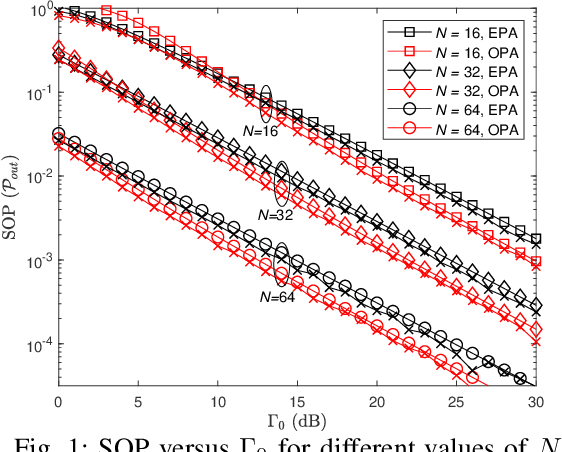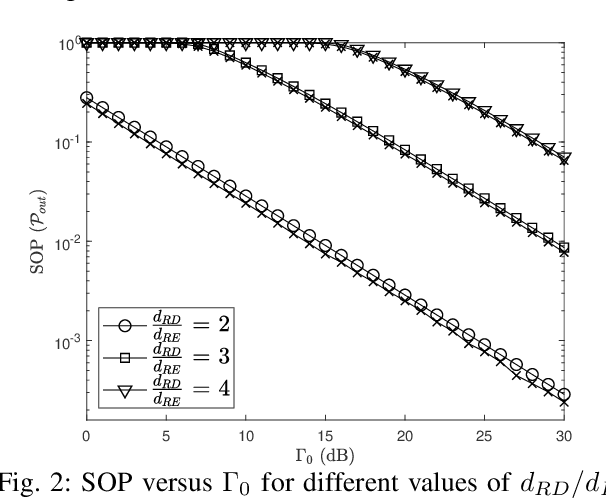Burhan Wafai
Secrecy Analysis of CSI Ratio-Based Transmitter Selection with Unreliable Backhaul
Jun 04, 2024Abstract:This paper explores the secrecy performance of a multi-transmitter system with unreliable backhaul links. To improve secrecy, we propose a novel transmitter selection (TS) scheme that selects a transmitter with the maximum ratio of the destination channel power gain to the eavesdropping channel power gain. The backhaul reliability factor is incorporated with the distribution of the channel power gain through the utilization of a mixture distribution. We evaluate the non-zero secrecy rate (NZR) and the secrecy outage probability (SOP) as well as their asymptotes in two scenarios of backhaul activity knowledge, where it is available and where it is unavailable. The results illustrate that because of the unreliable backhaul, the proposed destination-to-eavesdropper channel power gain ratio-based TS scheme is constrained in terms of secrecy performance. However, performance enhancements are observed when the backhaul knowledge activity is utilized. Furthermore, the proposed scheme outperforms all the sub-optimal TS schemes and achieves nearly optimal performance without requiring noise power or the evaluation of the exact secrecy rate measurement.
Opportunistic User Scheduling for Secure RIS-aided Wireless Communications
Mar 05, 2024Abstract:In this paper, we provide expressions for the secrecy outage probability (SOP) for suboptimal and optimal opportunistic scheduling schemes in a reconfigurable intelligent surface (RIS) aided system with multiple eavesdroppers in approximate closed form. A suboptimal scheduling (SS) scheme is analyzed, which is used when the channel state information (CSI) of the eavesdropping links is unavailable, and the optimal scheduling (OS) scheme is also analyzed, which is used when the global CSI is available. For each scheme, we provide a simplified expression for the SOP in the high signal-to-noise ratio (SNR) regime to demonstrate its behavior as a function of the key system parameters. At high SNR, the SOP saturates to a constant level which decreases exponentially with the number of RIS elements in the SS scheme and with the product of the number of RIS elements and the number of users in the OS scheme. We compare the performance of the opportunistic user scheduling schemes with that of a non-orthogonal multiple access (NOMA) based scheduling scheme which chooses a pair of users in each time slot for scheduling and we show that the opportunistic schemes outperform the NOMA-based scheme. We also derive a closed-form expression for the SOP of a decode-and-forward (DF) relay-aided scheduling scheme in order to compare it with that of the RIS-aided system. It is found that the RIS-aided system outperforms the relay-aided systems when the number of RIS elements is sufficiently large. An increased number of RIS elements is required to outperform the relay-aided system at higher operating frequencies.
Secrecy of Opportunistic User Scheduling in RIS-Aided Systems: A Comparison with NOMA Scheduling
Jun 05, 2023Abstract:In this paper, we propose an opportunistic user scheduling scheme in a multi-user reconfigurable intelligent surface (RIS) aided wireless system to improve secrecy. We derive the secrecy outage probability (SOP) and its asymptotic expression in approximate closed form. The asymptotic analysis shows that the SOP does not depend on the transmitter-to-RIS distance and saturates to a fixed value depending on the ratio of the path loss of the RIS-to-destination and RIS-to-eavesdropper links and the number of users at high signal-to-noise ratio. It is shown that increasing the number of RIS elements leads to an exponential decrease in the SOP. We also compare our scheme with that of a non-orthogonal multiple access (NOMA) scheduling scheme, which chooses a pair of users to schedule in each time slot. The comparison shows that the SOP of all of the NOMA users is compromised, and that our proposed scheduling scheme has better performance.
Transmitter Selection for Secrecy Against Colluding Eavesdroppers with Backhaul Uncertainty
Jan 02, 2023Abstract:In this paper, the secrecy performance of a multi-transmitter system with unreliable wireless backhaul links in the presence of multiple colluding eavesdroppers is considered. To improve the secrecy performance, two sub-optimal and optimal transmitter selection schemes are proposed. A generalized approach for the secrecy performance analysis is adopted to integrate the backhaul link reliability factor with the channel signal-to-noise ratio (SNR) through a mixture distribution depending on whether the backhaul reliability knowledge is unavailable or available. Non-zero secrecy rate (NZSR), secrecy outage probability (SOP), and ergodic secrecy rate (ESR) are evaluated for each selection schemes via a unified channel SNR ratio distribution based approach. Simplified asymptotic expressions are provided in each case to elucidate the infulence of the system parameters and of the backhaul reliability factor. We observe that the unreliable backhaul limits the secrecy performance of transmitter selection schemes by saturating the NZSR and SOP performance and by reducing the rate of change of the ESR with SNR. The performance improves when the knowledge of backhaul link activity is utilized, and the improvement is most noticeable when the backhaul is highly unreliable. We also observe that while the secrecy performance degrades with an increasing number of eavesdroppers, neither the asymptotic saturation value of the NZSR and SOP nor the rate of ESR improvement with SNR depends on the number of eavesdroppers.
Optimal Friendly Jamming and Transmit Power Allocation in RIS-assisted Secure Communication
Aug 02, 2022



Abstract:This paper analyzes the secrecy performance of a reconfigurable intelligent surface (RIS) assisted wireless communication system with a friendly jammer in the presence of an eavesdropper. The friendly jammer enhances the secrecy by introducing artificial noise towards the eavesdropper without degrading the reception at the destination. Approximate secrecy outage probability (SOP) is derived in closed form. We also provide a simpler approximate closed-form expression for the SOP in order to understand the effect of system parameters on the performance and to find the optimal power allocation for the transmitter and jammer. The optimal transmit and jamming power allocation factor is derived by minimizing the SOP assuming a total power constraint. It is shown that the SOP performance is significantly improved by the introduction of the jammer and a gain of approximately $3$ dB is achieved at an SOP of $10^{-4}$ by optimally allocating power compared to the case of equal power allocation.
Transmitter Selection for Secrecy in Cognitive Small-Cell Networks with Backhaul Knowledge
Feb 16, 2021



Abstract:A small-cell network with multiple transmitters and unreliable wireless backhaul is considered for secrecy enhancement. The small-cell network is operating under a spectrum sharing agreement with a primary network in a cognitive radio system. A constraint on the desired outage probability at the primary receiver is assumed as a part of the spectrum sharing agreement. The reliability of the wireless backhaul links are modeled by a set of independent and identically distributed Bernoulli random variables. A sub-optimal and an optimal small-cell transmitter selection (TS) scheme is proposed to improve the performance of the system, depending on the availability of channel state information. Selection schemes are designed for the scenario where knowledge is available regarding which backhaul links are active. The corresponding secrecy outage probabilities along with their asymptotic expressions are derived. It is shown that the secrecy performance is significantly improved compared to the case where knowledge of the active backhaul links is unavailable.
 Add to Chrome
Add to Chrome Add to Firefox
Add to Firefox Add to Edge
Add to Edge